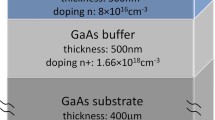Abstract
The results of an experimental study of the capacitance–voltage (C–V) characteristics and deep-level transient spectroscopy (DLTS) spectra of p+–p0–i–n0 homostructures based on undoped dislocationfree GaAs layers and InGaAs/GaAs and GaAsSb/GaAs heterostructures with homogeneous networks of misfit dislocations, all grown by liquid-phase epitaxy (LPE), are presented. Deep-level acceptor defects identified as HL2 and HL5 are found in the epitaxial p0 and n0 layers of the GaAs-based structure. The electron and hole dislocation-related deep levels, designated as, respectively, ED1 and HD3, are detected in InGaAs/GaAs and GaAsSb/GaAs heterostructures. The following hole trap parameters: thermal activation energies (E t ), capture cross sections (σ p ), and concentrations (N t ) are calculated from the Arrhenius dependences to be E t = 845 meV, σ p = 1.33 × 10–12 cm2, N t = 3.80 × 1014 cm–3 for InGaAs/GaAs and E t = 848 meV, σ p = 2.73 × 10–12 cm2, N t = 2.40 × 1014 cm–3 for GaAsSb/GaAs heterostructures. The concentration relaxation times of nonequilibrium carriers are estimated for the case in which dislocation-related deep acceptor traps are involved in this process. These are 2 × 10–10 s and 1.5 × 10–10 s for, respectively, the InGaAs/GaAs and GaAsSb/GaAs heterostructures and 1.6 × 10–6 s for the GaAs homostructures.
Similar content being viewed by others
References
Zh. I. Alferov, V. I. Korol’kov, V. G. Nikitin, M. N. Stepanova, and D. N. Tret’yakov, Sov. Tech. Phys. Lett. 2, 76 (1976).
F. Yu. Soldatenkov, V. G. Danil’chenko, and V. I. Korol’kov, Semiconductors 41, 211 (2007).
V. G. Danil’chenko, V. I. Korol’kov, and F. Yu. Soldatenkov, Semiconductors 43, 1055 (2009).
V. A. Kozlov, F. Yu. Soldatenkov, V. G. Danilchenko, V. I. Korolkov, and I. L. Shulpina, in Proceedings of the 25th Advanced Semiconductor Manufacturing Conference, Saratoga Springs, USA, May 19–21, 2014, p. 139.
M. M. Sobolev, F. Yu. Soldatenkov, and V. A. Kozlov, Semiconductors 50, 924 (2016).
M. M. Sobolev, P. R. Brunkov, S. G. Konnikov, M. N. Stepanova, V. G. Nikitin, V. P. Ulin, A. Sh. Dolbaya, T. D. Kamushadze, and R. M. Maisuradze, Sov. Phys. Semicond. 25, 637 (1989).
P. N. Brunkov, S. Gaibullaev, S. G. Konnikov, V. G. Nikitin, M. I. Papentsev, and M. M. Sobolev, Sov. Phys. Semicond. 25, 205 (1991).
G. M. Martin, A. Mitonneau, and A. Mircea, Electron. Lett. 13, 666 (1977).
A. Mitonneau, G. M. Martin, and A. Mircea, Electron. Lett. 13, 191 (1977).
V. A. Kaluchov and S. I. Chikichev, Phys. Status Solidi 88, K59 (1985).
A. Z. Li, H. K. Kim, J. C. Jeong, D. Wong, T. E. Schlesinger, and A. G. Milnes, J. Appl. Phys. 64, 3497 (1988).
Kohjib Yamada and Kazumi Wada, Inst. Phys. Conf. Ser. 106, 153 (1989).
B. H. Yang, Z. G. Wang, H. J. He, and L. Y. Lin, J. Cryst. Growth 103, 371 (1990).
O. Yastrubchak, T. Wosinski, A. Makosa, T. Figielski, S. Porowski, I. Grzegory, R. Czernecki, and P. Perlin, Eur. Phys. J. Appl. Phys. 27, 201 (2004).
T. Wosiński, A. Makosa, and J. Raczyńska, Acta Phys. Polon. A 87, 369 (1995).
V. G. Danil’chenko, V. I. Korol’kov, S. I. Ponomarev, and F. Yu. Soldatenkov, Semiconductors 45, 515 (2011).
I. L. Shul’pina, V. V. Ratnikov, V. A. Kozlov, F. Yu. Soldatenkov, and V. E. Voitovich, Tech. Phys. 59, 1566 (2014).
C. O. Thomas, D. Kahng, and R. C. Manz, J. Electrochem. Soc. 109, 1055 (1962).
E. S. Yang, J. Appl. Phys. 45, 3801 (1974).
J. P. Donnelly and A. G. Milnes, IEEE Trans. Electron Dev. 14, 63 (1967).
M. M. Sobolev, A. V. Gittsovich, M. I. Papentsev, I. V. Kochnev, and B. S. Yavich, Sov. Phys. Semicond. 26, 985 (1992).
D. V. Davydov, A. L. Zakgeim, F. M. Snegov, M. M. Sobolev, A. E. Chernyakov, A. S. Usikov, and N. M. Shmidt, Tech. Phys. Lett. 33, 143 (2007).
V. Bonch-Bruevich and S. Kalashnikov, Semiconductor Physics (Nauka, Moscow, 1977), p. 672 [in Russian].
H. F. Mataré, Defect Electronics in Semiconductors (Wiley-Interscience, New York, London, Sydney, Toronto, 1971).
B. Lax and S. F. Neustadter, J. Appl. Phys. 25, 1148 (1954).
B. R. Gossik, J. Appl. Phys. 27, 905 (1956).
Author information
Authors and Affiliations
Corresponding author
Additional information
Original Russian Text © M.M. Sobolev, F.Yu. Soldatenkov, 2018, published in Fizika i Tekhnika Poluprovodnikov, 2018, Vol. 52, No. 2, pp. 177–183.
Rights and permissions
About this article
Cite this article
Sobolev, M.M., Soldatenkov, F.Y. Effect of Dislocation-related Deep Levels in Heteroepitaxial InGaAs/GaAs and GaAsSb/GaAs p–i–n Structures on the Relaxation time of Nonequilibrium Carriers. Semiconductors 52, 165–171 (2018). https://doi.org/10.1134/S1063782618020173
Received:
Accepted:
Published:
Issue Date:
DOI: https://doi.org/10.1134/S1063782618020173




